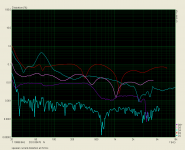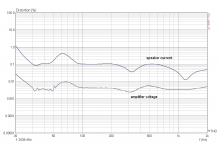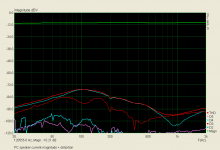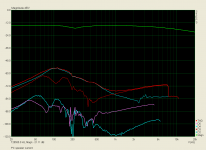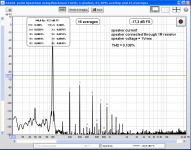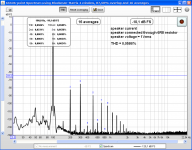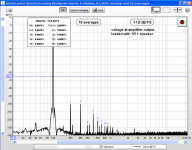How would you characterize the benefits vs. disadvantages of this type of design?
Umm, of that approach, it allows one to adjust the drivers Qe up and down which back then was more of an advantage than now as one can "design" a cabinet around a drivers parameters.
When lowering Qe, also reduced the distortion in the radiator motion some.
I have one of these too although I’s ancient now. It also has that kind of adjustable output impedance.
You will notice they apparently don’t give the weight. This guy is an arm stretcher, I would guess 120lb.
http://www.crownaudio.com/media/pdf/legacy/DO2000_Broc.pdf
So far as an accelerometer, a position sensor, a tach generator, when you add any of these into a feed back loop, you are adding the response, distortion, noise, dynamic properties of that sensor.
Most of the drivers I “closed the loop” on were large Servomotor driven woofers which while rotary motors, were like a voice coil with infinite xmax (once the rotary motion was converted to linear and connected to pistons).
With servomotors and other rotary systems, one way to get “information” was a tach generator which was a tiny very linear motor used as a generator. It produces a Voltage proportional to speed and served in systems where one needed rock solid control of a motor. It’s limit so far as audio use was the noise that the was part of the voltage. I played with a couple accelerometers too, these can be good but like a loud speaker, works best well below max G and well above the noise floor. The back emf approach can work well but a part I can’t tell you about because of work.
I can say that in my fiddling, one was limited to about 10 dB of negative feedback before you were getting close bode squeeling, but on a loudspeaker, that is a lot.
The thing is, closed loop feed back on a transducer, requires a separate transducer to get the “what it’s doing” signal and you are including it’s transfer function and noise into your system by putting it in the feed back loop.
Also, for a low frequency speaker where my interest was, since one has a system that says “I will add as much correction as needed to be where I should be”, one must plan ahead for Xmech and avoid the dred “bang bang bang driver death" as your feed back tries to get more excursion than the drivers suspension and or frame will allow.
Best
Tom
Very nice measurements, thank you for your efforts.
Vs = L dI/dt + I dL/dt + IR.
The inductance of a voice coil has a velocity component which is proportional to the absolute value of the coil velocity within the gap.
This will also be modulated by the conductance of the pole pieces.
jn
So,
Lc = L1 + L2*abs(d(Vc))
where Vc is the coil displacement?
And what is the R and L values of the skin effect and eddy currents proportional to?
Last edited:
I understand that the so called "back emf" was a very big issue in the era of tube amplifiers, as demonstrated in articles from the fifties of the past century that George has linked here.
Now it is not. Distortion of speaker current is in orders higher than that of amplifier voltage. And non-flat distortion at amplifier output voltage reflects the fact that my amp has 0.25 ohm output impedance and no global feedback.
Interesting is also a frequency dependence of individual speaker current harmonics.
Now it is not. Distortion of speaker current is in orders higher than that of amplifier voltage. And non-flat distortion at amplifier output voltage reflects the fact that my amp has 0.25 ohm output impedance and no global feedback.
Interesting is also a frequency dependence of individual speaker current harmonics.
Attachments
YesI suppose this is because it's not physically coupled to the voicecoil? And at frequencies where the cone inertia prevented movement between the coil and shorting ring, the ring would behave as if it was physically coupled to the coil, and act as a shorted turn on the coil, shorting out the back-EMF?.
No, at low frequencies it will be able to fully play its role (provided its resistivity is low enough, which becomes an issue at LF)If so, then I wonder at what frequencies this occurs. If the current drive impedance necessary to make a large improvement is 330R or so, and shorting ring impedance is close to zero at a very high frequency, it may still be low enough at low frequencies to thwart current drive.
The shorting effect can only take place if the movement of the coil is restricted wrt. the ring, by inertia, friction, or similar
And we're looking at ... ? 🙂
Unless I'm missing something totally obvious, that looks pretty good - I read it as better than 60dB down distortion everywhere, which is the ball park figure for speakers, as a species ...
On a side note, an interesting, extreme example of the need for speaker playback conditioning - "oh, no ... " I can hear the gasps already, 😀 - I've been forced to use another laptop, a less old, much higher quality Dell. I've already mentioned elsewhere that the quality of its sound system is pretty abysmal, which did surprise me a bit. Then yesterday, it was even worse again - what's going on? Then, a chance combination of YouTube clips I looked at this morning, and the sound of them, suddenly snapped on the light bulb - the tiny speakers in this fellow desperately, desperately need to very heavily driven, for quite a while, to make them work half decently - the reasons would probably be a combination of age and the tinyness of the speakers, making accurate assembly difficult.
Surprisingly, the speakers start to make noises at 80Hz, and manage to hit 11kHz - and are pretty clean from 2k on to that top frequency. But they were a complete mess at that audible bottom end; using a slowly increasing frequency sweep the most impressive set of twitterings, gurgles, blubbering, farts were produced, all the noises of the jungle - massive distortion! ... in the beginning!!! As an experiment, I kept on running the sweep through, over and over again, at max. volume - and each time it got better - the cacophony of crazy noises steadily subsided; it actually started to sound like a frequency sweep, even at the lowest frequencies. Finally, tried a video which had sounded like a disaster yesterday - lo and behold, quite reasonable! No guts, no real volume - but perfectly listenable to ...
Again, this is the most extreme example I've come across of the need to "warm up" the playback - I think even some of those here might pick up the difference, with a fair wind, 😛.
Unless I'm missing something totally obvious, that looks pretty good - I read it as better than 60dB down distortion everywhere, which is the ball park figure for speakers, as a species ...
On a side note, an interesting, extreme example of the need for speaker playback conditioning - "oh, no ... " I can hear the gasps already, 😀 - I've been forced to use another laptop, a less old, much higher quality Dell. I've already mentioned elsewhere that the quality of its sound system is pretty abysmal, which did surprise me a bit. Then yesterday, it was even worse again - what's going on? Then, a chance combination of YouTube clips I looked at this morning, and the sound of them, suddenly snapped on the light bulb - the tiny speakers in this fellow desperately, desperately need to very heavily driven, for quite a while, to make them work half decently - the reasons would probably be a combination of age and the tinyness of the speakers, making accurate assembly difficult.
Surprisingly, the speakers start to make noises at 80Hz, and manage to hit 11kHz - and are pretty clean from 2k on to that top frequency. But they were a complete mess at that audible bottom end; using a slowly increasing frequency sweep the most impressive set of twitterings, gurgles, blubbering, farts were produced, all the noises of the jungle - massive distortion! ... in the beginning!!! As an experiment, I kept on running the sweep through, over and over again, at max. volume - and each time it got better - the cacophony of crazy noises steadily subsided; it actually started to sound like a frequency sweep, even at the lowest frequencies. Finally, tried a video which had sounded like a disaster yesterday - lo and behold, quite reasonable! No guts, no real volume - but perfectly listenable to ...
Again, this is the most extreme example I've come across of the need to "warm up" the playback - I think even some of those here might pick up the difference, with a fair wind, 😛.
The pair of Genesis 1's I have experience with ran four wire connection to each 12'' woofer, all 12 of them !.The IRS that I played with used a strain gauge.
I understand these are development of the IRS.
Either way, seriously impressive bass.
Looking back at Hawksford's 1984 article, I see that his measured results
of lower distortion for current-source driving were with motional feedback.
Personally, I have also done this sort of thing with microphones, secondary
voice coils, and current-sensed feedback. They all work as long as you don't
expect miracles.
😎
I have a pair of these Sony SA-H7900
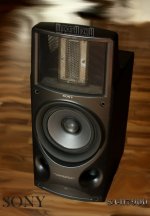
MFB woofer via secondary voice coil and ES tweeter.
The bass is unusually extended for an 8'', and sounding clean, clear and 'solid', without the usual resonance signature of a ported box.
With some tweaking they would make really good B system boxes, and being active all that is needed to drive them is an iPod.
Dan.
Last edited:
The pair of Genesis 1's I have experience with ran four wire connection to each woofer.
I understand these are development of the IRS.
Either way, seriously impressive bass.
I am just about to start reconditioning a modulus subwoofer circa 1990 spec, which I believe to be servostatik as well. Been lingering in storage since 1998 and the foam has rotted out. Hoping for seriously impressive bass, currently got seriously unimpressed Memsahib 🙂
How many here have heard the Philips Motional Feedback speaker models in real life? As either Philips or Grundig?
Any who did will probably greatly enjoy this discussion, as those models clearly demonstrated that there is much sense in this topic and a lot of ground needs to be covered.
The one side of this topic which has been mentioned only in passing is the damping factor of the amp(s). How important is it really in all this? Did Kenwood really get it right with their Sigma drive, advertised at the time for its extreme damping factor of over 1.000:1 and said to eliminate the byproducts of the speaker cable?
Any who did will probably greatly enjoy this discussion, as those models clearly demonstrated that there is much sense in this topic and a lot of ground needs to be covered.
The one side of this topic which has been mentioned only in passing is the damping factor of the amp(s). How important is it really in all this? Did Kenwood really get it right with their Sigma drive, advertised at the time for its extreme damping factor of over 1.000:1 and said to eliminate the byproducts of the speaker cable?
The thing is, closed loop feed back on a transducer, requires a separate transducer to get the “what it’s doing” signal and you are including it’s transfer function and noise into your system by putting it in the feed back loop.
Also, for a low frequency speaker where my interest was, since one has a system that says “I will add as much correction as needed to be where I should be”, one must plan ahead for Xmech and avoid the dred “bang bang bang driver death" as your feed back tries to get more excursion than the drivers suspension and or frame will allow.
Best
Tom
Given the one thing we have now that wasn't available back then is MIPS do you know if any research has been done on predistortion systems for this?
Get Over It And Get On With It...
That said there are plenty of new surrounds available on eBay etc, also vulcanised replacements.
So, that brings a question...is it ok to replace the original surround with a slightly/somewhat different surround ?
The servo system should be able to compensate for differing surrounds ????.
I hope you have fun with it when you get it working, two would be even more fun provided you can get it/them to integrate properly.
I am yet to hear a sub that I can live with, that said, I expect that a servo sub has more chance of being decent and correctly complimenting existing BMH speakers.
Dan.
Lol, foam surrounds are from the devil/mongrels....guaranteed obsolescence....bastards !.I am just about to start reconditioning a modulus subwoofer circa 1990 spec, which I believe to be servostatik as well. Been lingering in storage since 1998 and the foam has rotted out. Hoping for seriously impressive bass, currently got seriously unimpressed Memsahib 🙂
That said there are plenty of new surrounds available on eBay etc, also vulcanised replacements.
So, that brings a question...is it ok to replace the original surround with a slightly/somewhat different surround ?
The servo system should be able to compensate for differing surrounds ????.
I hope you have fun with it when you get it working, two would be even more fun provided you can get it/them to integrate properly.
I am yet to hear a sub that I can live with, that said, I expect that a servo sub has more chance of being decent and correctly complimenting existing BMH speakers.
Dan.
Last edited:
The replacements appear to be the same foam (from springfieldspeaker).
Given space constraints one is all I can fit in. I bought the modulus satellites in 1992, but back then the sub was £1600, which was more than my car cost me. Sub was picked up cheap as had no controller in chicago in 97 and controller has remained half built since then as the breeding years got in the way.
But when the wife says 'so subwoofer next' you roll with it 🙂
Given space constraints one is all I can fit in. I bought the modulus satellites in 1992, but back then the sub was £1600, which was more than my car cost me. Sub was picked up cheap as had no controller in chicago in 97 and controller has remained half built since then as the breeding years got in the way.
But when the wife says 'so subwoofer next' you roll with it 🙂
And we're looking at ... ? 🙂
Unless I'm missing something totally obvious, that looks pretty good - I read it as better than 60dB down distortion everywhere, which is the ball park figure for speakers, as a species ...
My bad Frank, sorry, wrong plot. It was a voltage plot with wrong label. Correct plots attached. However, it is not bad, regarding current distortion, measured at 1.4Vrms, which is a lot for this small one. But the sound is distorted horribly - plastic box resonances etc. You would not believe, that PC speaker is a tough load, especially for small amplifiers - it has Re = 3.6 ohm only. Pretty low impedance for some pocket audio. But no sudden dips and peaks.
Attachments
Lol, foam surrounds are from the devil/mongrels....guaranteed obsolescence....bastards !.
That said there are plenty of new surrounds available on eBay etc, also vulcanised replacements.
So, that brings a question...is it ok to replace the original surround with a slightly/somewhat different surround ?
The servo system should be able to compensate for differing surrounds ????.
I hope you have fun with it when you get it working, two would be even more fun provided you can get it/them to integrate properly.
I am yet to hear a sub that I can live with, that said, I expect that a servo sub has more chance of being decent and correctly complimenting existing BMH speakers.
Dan.
Dan, I had exactly the same problem in the late 90ies when I discovered that my acoustic suspension ARs were in fact workig as bass reflef drivers since the foam had literally disintegrated, vapourised.
There is a company in Germany specializing in real rubber surround suspension replacements, and had a whopping big replacement chart book, naming speakers in details. Unfortunately, I only saw it on someone else's computer, and have forgotten their name, and the guy wouldn't give it to me for fear I might take his bread away from him, or whatever. But we have native Germans here, so perhaps they can help. If memory serves, some of them are in speakers up to their ears.
He did find my exact model, AR94, ordered and received them fairly quickly. He also installed them. While I honestly cannot swear that the speakers are now as new, any difference between as new and with new suspensions I can vouch for the fact that any differences are small enough not to be easily detectable,
And the price was nothing fearsome.
speaker distortion is lower with current drive
This measurement shows that speaker current distortion decreased to almost one half when the speaker was driven from 6.8 ohm series resistor, compared to 1 ohm series resistor. In both cases, voltage at speaker terminals (behind the resistor) was 1Vrms. This is a proof that current drive generates less distortion in speaker current than voltage drive. So, a "wire with gain" is not the best solution re resulting distortion at acoustical side.
This measurement shows that speaker current distortion decreased to almost one half when the speaker was driven from 6.8 ohm series resistor, compared to 1 ohm series resistor. In both cases, voltage at speaker terminals (behind the resistor) was 1Vrms. This is a proof that current drive generates less distortion in speaker current than voltage drive. So, a "wire with gain" is not the best solution re resulting distortion at acoustical side.
Attachments
Not I, unfortunately....all comments that I have read are complimentary in the bass, not so much for the highs....Phillips tweeter 12kHz resonance ?.How many here have heard the Philips Motional Feedback speaker models in real life? As either Philips or Grundig?
I have the little Sony's that I mention, and I spent a day with Genesis 1 system.
2000W + 2000W 16 Hz to 120 Hz in a very large room blurred ones vision and felt good, way good.

Yeah, ime servo bass is good, really good.Any who did will probably greatly enjoy this discussion, as those models clearly demonstrated that there is much sense in this topic and a lot of ground needs to be covered.
I repaired one when I was an apprentice.The one side of this topic which has been mentioned only in passing is the damping factor of the amp(s). How important is it really in all this? Did Kenwood really get it right with their Sigma drive, advertised at the time for its extreme damping factor of over 1.000:1 and said to eliminate the by products of the speaker cable?
Back then I did not have the experience/appreciation/discrimination that I now have so I can't give proper comment on those...sorry about that.
My big PA amp quotes DF of 500 with 4 ohm load..when running two cabinets per channel the bass results were really good, particularly on transient sounds like rock drums and bass guitar, and I do reckon that the DF is part of that.
There are all sorts of arguments both ways (low or high DF).
What does damping factor really mean ?.
The usual test method describes AC output impedance.
The practical reality is the amplifier's ability/efficacy to quench loudspeaker kinetically derived return energy.
Power supply low resistance DC connections and power supply LF low impedance AC behaviour are the critical factors here, as are earthing arrangements.
The loudspeaker return energy has to go somewhere, and into the reservoir caps is where it ends up, and in so doing modulates the amplifier power rails.
This all sets up a loop condition, with NFB and PSRR being further critical behaviours.
Get all of that right and you get a dynamically load invariant amp.
Far too many amplifiers suffer at least one if not all of the above dependencies.
Dan.
Last edited:
This measurement shows that speaker current distortion decreased to almost one half when the speaker was driven from 6.8 ohm series resistor, compared to 1 ohm series resistor.
Is the spectrum normalized to the frequency response change?
This could be the mob you're thinking of, Dejan, Dr. Kurt Müller: Dr. Kurt Mueller - Lynn Olson mentions them.There is a company in Germany specializing in real rubber surround suspension replacements, and had a whopping big replacement chart book, naming speakers in details. Unfortunately, I only saw it on someone else's computer, and have forgotten their name, and the guy wouldn't give it to me for fear I might take his bread away from him, or whatever. But we have native Germans here, so perhaps they can help. If memory serves, some of them are in speakers up to their ears.
- Status
- Not open for further replies.
- Home
- Member Areas
- The Lounge
- John Curl's Blowtorch preamplifier part II
